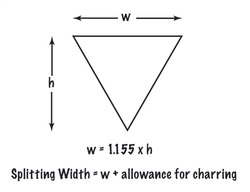splitting - an alternate method (page 2)
Groups of four strips are easily split into two's and the two's into one's, so work toward dividing the butt material into groups of four singles and tip material into groups of four doubles.
Splitting width: finished half diameter at thick end of strip + 15% + allowance for charring of nodes and leeway. (2)
First determine the splitting widths. If you're not sure of your allowance for charring and leeway, use Mr. Garrison's widths from page 11 of his book. Then, after splitting and straightening the nodes, place a pencil mark near each node where the charring ends. Measure the width at each mark. Plane the sides of the strip to remove charred bamboo at the enamel edge and measure the width again. Note the loss. Add another .015" leeway to the largest loss to get the total allowance.
Allowances that are too great mean fewer strips and excessive work in straightening and planing, but until you have split a culm or two this way it is wise to err on the conservative side.
After drawing the usual spiral lines, run a piece of masking tape around the lower ends of the butt and tip pieces of culm. Begin and end at the major split. Look for blemishes, leaf nodes and secondary splits or whatever that would cause you to discard a strip and transfer the location of these relative to the major split up to the masking tape.
Dividers: use any type that will hold a setting.
On the butt piece, set your dividers to the splitting width for single butt strips and, beginning at the major split, step off that width around the tape. Do this on the edge of the tape nearest the end of the culm. Use a very sharp pencil to highlight the divider marks in the tape. Now, count the number of whole strips. On an ideal culm there would be an exact multiple of four, but that isn't likely so some juggling will be necessary. You want to maximize the groups of four good strips and place the remainder where they will present the least problem. If there is a blemish, leaf node or whatever, it may help to step off strip widths to that blemish each way from the major split and have the remainder include the blemish. Then, even if there is run-out, it will be into a strip or strips that will be discarded.
If you are short of a group of four by one strip or less, consider resetting your dividers slightly smaller and stepping off again.
It isn't possible here to cover all the situations that might arise. Don't hesitate to pull off the tape and start again. Once you have arrived at the best arrangement, mark the tape to show the groups of four and any remainder. With a razor knife, slice the tape lengthwise to the culm at each strip mark to prevent the tape from being pulled off during splitting.
For the tip culm set your dividers for double strips. All other steps are the same.
----------
(1) To convert the height of an equilateral triangle to the length of its side. Precise factor is 15.5% but 15% is close enough and can easily be calculated.
(2) Careful measuring of 60 butt strip nodes straightened after soaking showed the maximum loss to charring was .039". On this basis the allowance and leeway was first set at .060", later reduced to .050". For tips, when soaked prior to straightening, it was set at .035".



